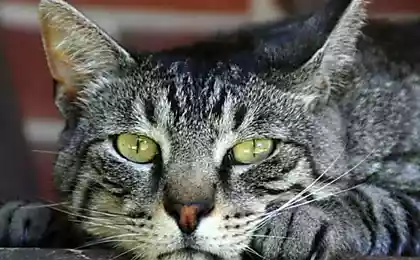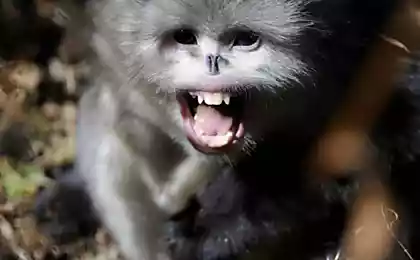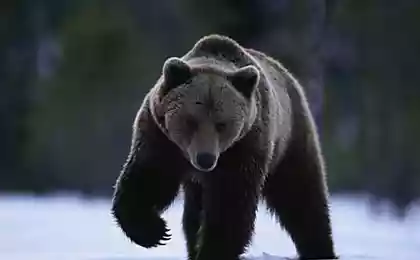1981
From the family chevrotain
Kanchil - species of mammals from the family chevrotain.

The growth of the deer - only 20-25 centimeters. A weigh - and a half pounds. The thickest members of the species reach two and a half kilograms
But despite the family ties with cloven-hoofed, mouse deer antlers have not - as, indeed, and all chevrotains (miniature ungulates). The deer mouse - soft and fluffy, they are covered with fur gray-brown in color, often with an orange tint. But these deer have fangs, they are before the enormous, that even speak of his mouth. These animals are the smallest members of the order Artiodactyla.
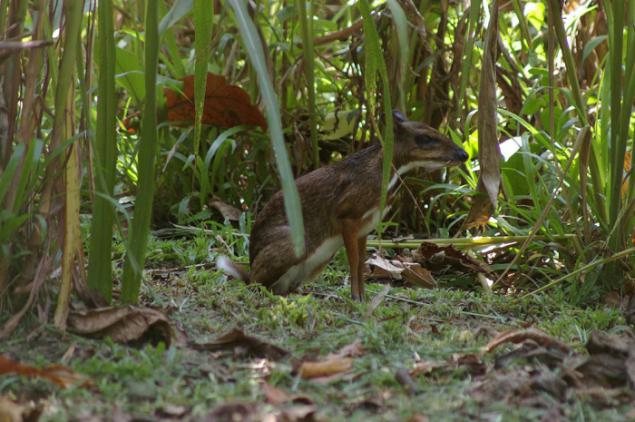
Kanchi (Asian Olenka, Tragulus), kind of cloven-hoofed animals chevrotains family includes 5 species. Resemble African Olenka, but smaller. The most famous big kanchil (Tragulus napu), having a weight of 5-8 kg, body length of 70-75 cm and a height of 30-35 cm. It inhabits the Malay Peninsula, Sumatra and Kalimantan islands. The smallest of Olenka - Small kanchil (Tragulus javanicus) - inhabits the island of Sumatra, Borneo and Java. The height of the hoof barely reaches 20-25 cm and weight of 2-2, 5 kg. Indian Mouse-deer (spotted kanchil, Tragulus meminna), lives in India and Ceylon. It features dark with small light spots color. For a number of signs of this kind of close to the African Olenka.

Kanchi inhabit dry forests with outcrops of rocks and mangroves. This secretive nocturnal animals that lead solitary lives. Only for a moment, you can see kanchilya in dense bush. When the persecution he hides, and being caught biting. Ghosn had kanchiley happens in June and July. Duration 150-155 days gestation. Females are more likely to bring kanchiley two calf.

His heyday Murine deer reached in the Miocene (23-5 million. Years ago), and the first paleontological finds date from the Oligocene (34 mln. Years ago). Currently, there is this relic, endangered group of animals - the only living representatives infraryada Tragulina (Tragulina). The closest relatives are Kanchiley and deer and pigs, with the first to have the general structure of the dental system and the digestive system, and the second similarity in the structure of the extremities, and in particular the presence of the four fingers. Ultimately, Murine deer are a shining example of the most ancient cloven-hoofed animals, from which all others evolved.

Kanchi inhabit the tropical rain forests of Central Africa and Southeast Asia. Their small size - a maximum of 80 cm in the African water Kanchi, wonderful help them move in the dense thickets of tropical forests, not gryaznut in marshy soil and the forest floor. These animals are very territorial and each individual takes, though not large - up to 13 hectares, but a permanent part of the forest. Happy Kanchi located in various places where they hide and feed at dusk and at night.

Today in the world there are only five species of these animals, and, in Africa, found only one species - the African Water kanchil (Hyemoschus aquaticus), and the rest - ie, Asian species: Large kanchil (Tragulus napu), Small kanchil (Tragulus javanicus) and Pyatnastaya kanchil (Moschiola mennina). It is said that in 2005, Sri Lanka has been described in five species - Sri Lankan kanchil (Moschiola kathygre).
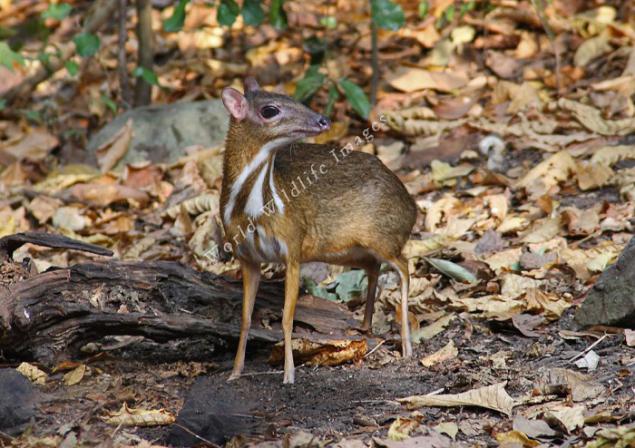
Eats whatever they are caught in the path of the leaves of tropical plants, mushrooms, fruits and seeds, to the beetles, frogs, fish and carrion. And these deer are actively hunting for fish in a small stakes, streams and rivulets. But the African Water kanchil spends a lot of time in the water and recover, may be called amphibious mammal - and here it feeds mainly here escapes from predators, while a very good swimmer.
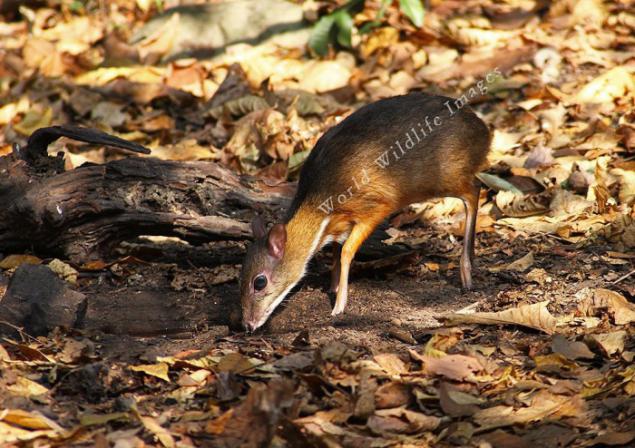
The presence of canines but does not make kanchiley impudent. On the contrary, it is a very shy animals that lead a secretive life. They are active mainly at night. During the day they sleep (in rock crevices or hollow logs). And at night wandering in search of food. They help them navigate in the dark forest big eyes. Olenka eat vegetarian food - leaves, flowers, fruits, etc. (skhrumkat and may resemble an insect). Although the legs with hooves these mice somehow manage, if necessary, and climb trees. Marvelous are thy works, O Lord. If in danger, sometimes Kanchi ischet rescue in water. They are excellent swimmers and can go on the bottom, not a long time leaning outwards.

Lead Kanchi, of course, single or monogamous lifestyle. Each of kanchiley edinovlastnym in possession of land - about 12 hectares (slightly less than in females - 8 hectares). It is so much crumbs that you need to feel comfortable.
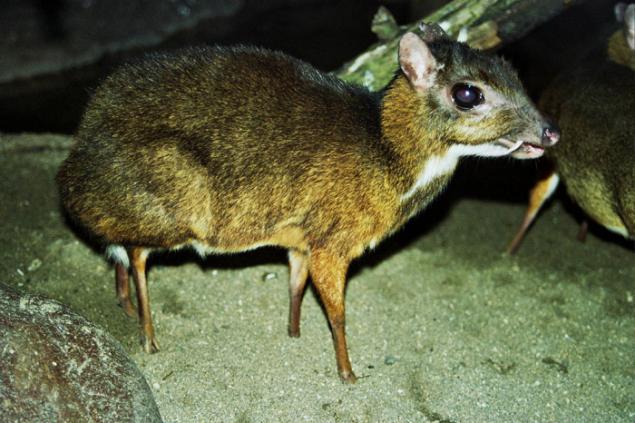


©

The growth of the deer - only 20-25 centimeters. A weigh - and a half pounds. The thickest members of the species reach two and a half kilograms
But despite the family ties with cloven-hoofed, mouse deer antlers have not - as, indeed, and all chevrotains (miniature ungulates). The deer mouse - soft and fluffy, they are covered with fur gray-brown in color, often with an orange tint. But these deer have fangs, they are before the enormous, that even speak of his mouth. These animals are the smallest members of the order Artiodactyla.

Kanchi (Asian Olenka, Tragulus), kind of cloven-hoofed animals chevrotains family includes 5 species. Resemble African Olenka, but smaller. The most famous big kanchil (Tragulus napu), having a weight of 5-8 kg, body length of 70-75 cm and a height of 30-35 cm. It inhabits the Malay Peninsula, Sumatra and Kalimantan islands. The smallest of Olenka - Small kanchil (Tragulus javanicus) - inhabits the island of Sumatra, Borneo and Java. The height of the hoof barely reaches 20-25 cm and weight of 2-2, 5 kg. Indian Mouse-deer (spotted kanchil, Tragulus meminna), lives in India and Ceylon. It features dark with small light spots color. For a number of signs of this kind of close to the African Olenka.

Kanchi inhabit dry forests with outcrops of rocks and mangroves. This secretive nocturnal animals that lead solitary lives. Only for a moment, you can see kanchilya in dense bush. When the persecution he hides, and being caught biting. Ghosn had kanchiley happens in June and July. Duration 150-155 days gestation. Females are more likely to bring kanchiley two calf.

His heyday Murine deer reached in the Miocene (23-5 million. Years ago), and the first paleontological finds date from the Oligocene (34 mln. Years ago). Currently, there is this relic, endangered group of animals - the only living representatives infraryada Tragulina (Tragulina). The closest relatives are Kanchiley and deer and pigs, with the first to have the general structure of the dental system and the digestive system, and the second similarity in the structure of the extremities, and in particular the presence of the four fingers. Ultimately, Murine deer are a shining example of the most ancient cloven-hoofed animals, from which all others evolved.

Kanchi inhabit the tropical rain forests of Central Africa and Southeast Asia. Their small size - a maximum of 80 cm in the African water Kanchi, wonderful help them move in the dense thickets of tropical forests, not gryaznut in marshy soil and the forest floor. These animals are very territorial and each individual takes, though not large - up to 13 hectares, but a permanent part of the forest. Happy Kanchi located in various places where they hide and feed at dusk and at night.

Today in the world there are only five species of these animals, and, in Africa, found only one species - the African Water kanchil (Hyemoschus aquaticus), and the rest - ie, Asian species: Large kanchil (Tragulus napu), Small kanchil (Tragulus javanicus) and Pyatnastaya kanchil (Moschiola mennina). It is said that in 2005, Sri Lanka has been described in five species - Sri Lankan kanchil (Moschiola kathygre).

Eats whatever they are caught in the path of the leaves of tropical plants, mushrooms, fruits and seeds, to the beetles, frogs, fish and carrion. And these deer are actively hunting for fish in a small stakes, streams and rivulets. But the African Water kanchil spends a lot of time in the water and recover, may be called amphibious mammal - and here it feeds mainly here escapes from predators, while a very good swimmer.

The presence of canines but does not make kanchiley impudent. On the contrary, it is a very shy animals that lead a secretive life. They are active mainly at night. During the day they sleep (in rock crevices or hollow logs). And at night wandering in search of food. They help them navigate in the dark forest big eyes. Olenka eat vegetarian food - leaves, flowers, fruits, etc. (skhrumkat and may resemble an insect). Although the legs with hooves these mice somehow manage, if necessary, and climb trees. Marvelous are thy works, O Lord. If in danger, sometimes Kanchi ischet rescue in water. They are excellent swimmers and can go on the bottom, not a long time leaning outwards.

Lead Kanchi, of course, single or monogamous lifestyle. Each of kanchiley edinovlastnym in possession of land - about 12 hectares (slightly less than in females - 8 hectares). It is so much crumbs that you need to feel comfortable.



©







